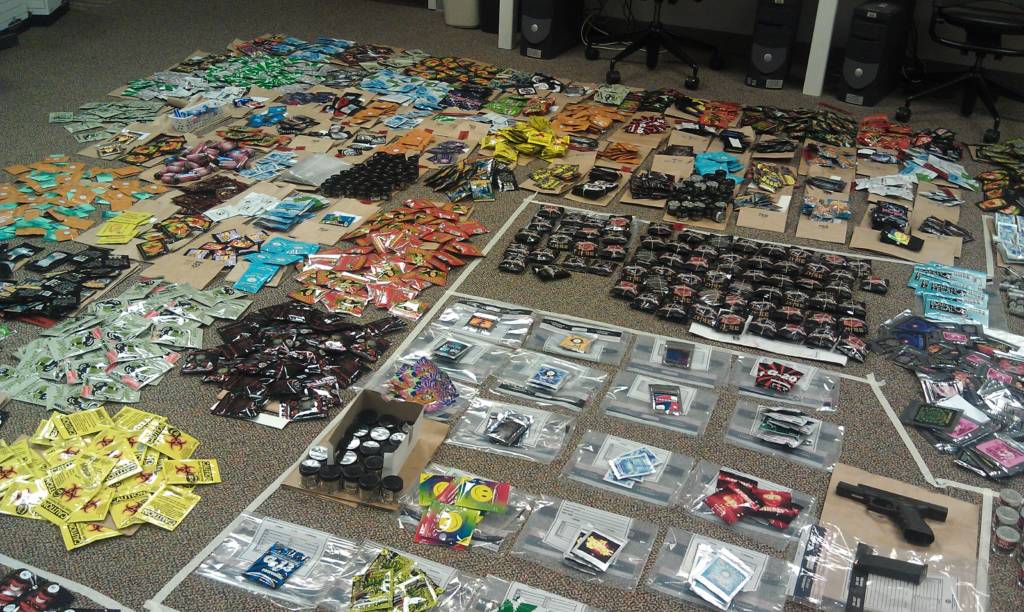Nationally, synthetic drugs have become a severe danger to youth. In the District, they are an adult problem: a homeless adult problem. Local testing data shows that usage occurs primarily among Black males ages 39 – 65.
In the summer of 2015, several mass-overdoses outside of shelters and the fatal stabbing of an American University alumnus and former congressional staffer forced these drugs into the local and national spotlight. Mayor Muriel Bowser was quick to pass emergency legislation to impose steep penalties for business owners caught peddling the substances. By the fall, two congressional acts had been proposed to address synthetic drugs. Both are still pending further action and have been co-sponsored by Representative Eleanor Holmes Norton (D-DC).
At an April community meeting, shelter resident and administrator Donald Page said that “the people you see standing around outside of 2nd and D [shelter] don’t live here. They prey upon the people that do.”
Metropolitan Police Department (MPD) Lieutenant Andrew Struhar agreed in a recent interview. “We know there’s not manufacturing at homeless sites,” he said. “And most dealers we arrest are not homeless either.”
However, the low cost and availability of synthetic drugs can be a tempting and affordable escape. MPD has been collaborating with city and national agencies in an attempt to stay ahead of the drug manufacturers. Focusing enforcement efforts on suppliers can be difficult, as they are located anywhere from here to California to China. But this strategy seems to be working.
“Like crack, it’s not gone,” Struhar said. “But it no longer has the same widespread impact on local society.” He has worked for the Federal Bureau of Investigation (FBI), the Bureau of Alcohol, Tobacco and Firearms (ATF) and served the MPD for nearly 23 years. Struhar started his career at the tail end of the crack epidemic and has maintained a focus on narcotics and gang enforcement.
Another summer is approaching. Weeks after a Tenleytown homeless man died from synthetic overdose, it is impossible to be certain that drug use will not rise along with the temperature. Yet, Struhar is confident that the worst is behind Washington.
MPD has been targeting synthetic drugs since 2013. The drugs’ increase in potency and their adaptive structures were unexpected and difficult to keep up with. “In 2013, use of the drug produced a mellow high similar to marijuana,” said the Lieutenant. “Now you see the more hallucinogenic effects. We may have engineered to that point – trying to evade tests and to provide increasingly strong products.”
The problem with synthetics has always been the chemicals with which they are laced. The compounds created with new chemicals or different mixtures result in a substance that may not be detectable with any standard test and one that is most likely not registered with the Controlled Substances Act. Struhar said However, labs have come a long way. As has legislation.
D.C. Council unanimously passed the “SAFE DC” Act, which makes it easier to “outlaw, test for, and prosecute sellers of these drugs,” according to an April 5 press release. District authorities can now prosecute cases if an unknown drug is similar in composition to an already illegal substance, rather than requiring a long legislative process to outlaw each new individual substance.
From legislation to emergency care, response time is everything when dealing with synthetics.
“All of our patrol officers go through a 4-hour class on synthetic drugs, but that’s just scratching the surface,” Struhar said.”Officers must make decisions with limited information.”
Synthetic drugs can often make the user appear to be struggling with a severe mental condition: babbling, catatonia, hallucinating or lashing out. But a person’s internal reaction is physical, and needs to be addressed immediately. Overdose patients “don’t need to go to CPEP [Comprehensive Psychiatric Emergency Program],” Struhar said. “They need to go to the hospital.”
“The calls I’ve gotten from the ER are terrible,” said Shawn Millan, communications director for Representative Charlie Dent (R-PA), who introduced the Synthetic Drug Control Act of 2015. “These drugs make a wreck of the kidneys and liver.”
Poison center experts have called synthetic drug use a risk to the public’s health and a hazard to public safety, according to a fact sheet assembled by the office of Congressman Mac Thornberry (R-TX), who introduced the 2015 SALTS Act. According to Struhar, addiction and rehabilitation care has not caught up with the new legislation or enforcement strategies: there is not yet a standard for treatment regarding these drugs.
Struhar recommended at least calling an ambulance if you suspect someone is under the influence and a danger to themselves or others. “There’s no procedure for this,” he said. “Keep a safe distance.”
Detailed and unexaggerated tips are an asset for the MPD’s ongoing pursuit of synthetic drug suppliers. The physical description of a person—and they’re vehicle if they use one—is most important. Knowledge of any habitual dealing locations and times is also helpful. Struhar gave the example of a particular car that the Father McKenna Center staff reported as parking suspiciously across the street from the day center at the same time every afternoon.
Struhar stressed that homeless people are not the only ones using these drugs in the area, simply some of the most vulnerable. He cited recent arrests of younger affluent white males in Frederick, Maryland. His team will continue to put forth a lot of outreach effort in the homeless community. There are too many names and forms of synthetic drugs to count: Bizarro, Scooby Snax, Trainwreck, Bath Salts, etc. But the most important part of the packaging isn’t the name, it’s the ubiquitous fine print: “not intended for human consumption.”
Read our vendors’ opinions on and/or experience with K2 here.




